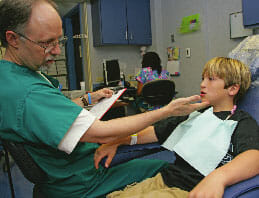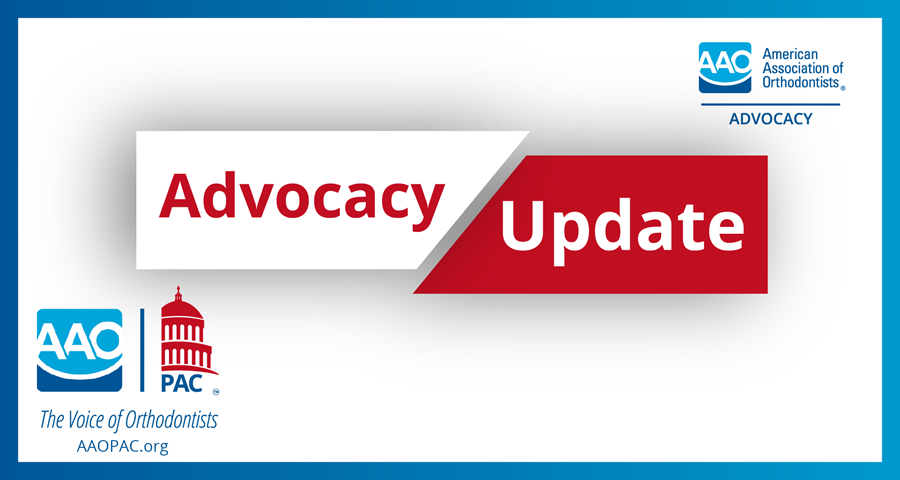- Resources for the Affordable Care Act Implementation
- ACA Impact to Vary from State to State
- Long Term Impact of the Affordable Care Act on Dental Care
- The Orthodontist as an Employer
- The ACA and Small Businesses
- The Shared Responsibility Payment for 2015 Employers with 50-Plus Employees
- Rhode Island Experiences Improvements in Coverage
- Arkansas, Texas Redefining Medically Necessary Orthodontics
The Affordable Care Act goes into effect on January 1. Complete information about how the ACA will impact orthodontists is not yet available.
The AAO encourages members to check regularly with resources listed below, and with dental insurers and benefit consultants in their states as well as state orthodontic organizations. In California, for example, Delta Dental produced a memo obtained by the California Association of Orthodontists, explaining that patients in the state must score 26 or more points on the Handicapping Labio-Lingual Deviations (HLD) form for their treatment to be considered medically necessary.
Resources for the Affordable Care Act Implementation
State Benchmark Plans: The Centers for Medicare & Medicaid Services (CMS)
http://www.cms.gov/CCIIO/Resources/Data-Resources/ehb.html
Information about the Affordable care Act Vis-à-Vis Small Business:
- https://www.healthcare.gov/what-is-the-shop-marketplace/
- https://www.healthcare.gov/small-businesses/
The Internal Revenue Service page includes a link to Form 8941, which enables an employer to claim the tax credit if employee insurance has been purchased through the SHOP Marketplace.
Impact of the Affordable Care Act on Businesses with 50 or More Employees
http://www.sba.gov/content/employers-with-50-or-more-employees
Although most AAO members have fewer than 50 employees, the U.S. Small Business Administration website includes key information for those with more than 50 employees.
Dr. Thomas Ahman, an AAO member in Lima, Ohio, has a number of cleft palate and craniofacial patients in his practice.
“Currently in Ohio, 70 percent of the cost of orthodontic treatment is covered for a cleft lip/cleft palate or craniofacial patient because their need is considered to be medically necessary orthodontic treatment,” says Dr. Ahman, who was the speaker of the AAO House of Delegates from 2007-2009. “When the Affordable Care Act begins on January 1, I hope that the benefit for these patients will be at least as good.”
Dr. Ahman began researching this question of how medically necessary orthodontic treatment will be defined in Ohio by clicking through to the Ohio PDFs on the cms.gov website (http://www.cms.gov/CCIIO/Resources/Data-Resources/ehb.html). The AAO sent the website link to members in an eBulletin on October 17.
“There is limited dental information about what is included in Ohio’s benchmark plan (the plan used to define benefits in the state under the Affordable Care Act),” says Dr. Ahman. “I could find nothing related to orthodontic treatment or to any specific dental services for cleft/craniofacial patients. Some types of oral surgery are covered, but that is the only reference that I found.”
Dr. Ahman’s staff began calling contacts in state offices to pursue the question about cleft/craniofacial patients’ coverage, but no one in the state offices was able to provide information.
It is likely that AAO members in other states have had experiences similar to Dr. Ahman’s. In other cases, members have been able to access details about orthodontic coverage in their states. Such success may be more likely in states that operate their own healthcare exchanges that are being implemented as part of the Affordable Care Act, as opposed to participating in the national exchange. Fifteen states and the District of Columbia are operating their own marketplaces (exchanges), while residents of other states may purchase insurance through the federally run exchange system.
“The Ohio Bureau for Children with Medical Handicaps (BCMH), which manages medical care, including orthodontic care, for all patients with cleft lip or palate, is advising parents of children with clefts or craniofacial defects to enroll in the federal exchange system,” says Dr. Ahman. “BCMH personnel are not yet able to report how this might affect their coverage or reimbursement, but they are, nevertheless, being directed to make this recommendation.“
ACA Impact to Vary from State to State
The AAO Legal Department has provided the following information related to the implementation of the Affordable Care Act (ACA) by the U.S. government, specifically as it relates to orthodontic treatment:
- There is nothing different or unexpected about how the ACA is rolling out as it relates to orthodontic care. The federal government established “essential health benefits,” which included medically necessary orthodontia. It did not define medically necessary orthodontia; instead, the federal government left that determination to the states.
- The result is a patchwork definition because what may be considered “necessary” in one state may not be in the next (see State Benchmark Plans, below). This circumstance does not fundamentally affect how orthodontic treatment is covered or how orthodontists will function in the post-ACA world.
- After the ACA implementation – as before – there will be insurance coverage that includes even routine orthodontic treatment. In the vast majority of states, this coverage will not be mandatory because it may not be deemed to be medically necessary.
- Orthodontists, like any other doctors, are free to accept insurance or not as they see fit. Within limits that are not applicable to this issue, orthodontists are not required to accept any particular patients.
- The insurance coverage offered through the exchanges being launched under the Affordable Care Act features several tiers of coverage. The majority of employer-sponsored coverage already meets the standards and is not affected, except to the extent that the cost of coverage may be more or less based upon a number of factors, including the risk pool and the existing standards of the states in which they operate. Highly regulated states may see lower premiums while lightly regulated states will likely see a jump.

State Benchmark Plans
States follow a specific process to determine the basis for all health coverage (not just dental and orthodontic) that would qualify for inclusion on the healthcare exchange:
Each state selected a benchmark plan, which is what the U.S. Department of Health and Human Services used to define the Essential Health Benefits (EHBs). Each benchmark plan is based on certain health plan options:
- The largest small group plan in the state;
- The largest state employee health plan;
- The largest insured commercial HMO in the state; and
- Any of the three largest national Federal Employees Health Benefits Program (“FEHBP”) plans.
Health plans that cover EHBs must offer benefits and services that are “substantially equal” to those in the benchmark plan. A look at each state’s benchmark plan may indicate how medically necessary orthodontia is defined in the state (if it is defined at all).
The Centers for Medicare & Medicaid Services (CMS) has a website section that provides each state’s benchmark plan and the state’s required benefits. To access state benchmark plans, the key resource is http://www.cms.gov/CCIIO/Resources/Data-Resources/ehb.html.
When searching state documents, use the term orthodontia, as well as orthodontic, to avoid missing any references to treatment in the state EHB.
Long Term Impact of the Affordable Care Act on Dental Care
The American Dental Association reports that the Affordable Care Act will likely have little impact on oral health care among adults.
The ADA estimates, however, that 3 million children will gain dental benefits through health insurance exchanges by 2018. Approximately 5 percent more children are expected to have dental benefits as compared with the situation in 2013. Additional children are expected to gain dental benefits through plans not purchased through the ACA exchange system, including employer-sponsored plans.
Another information resource is a dentalinsurance.org article, “How Obamacare Will Impact Kids’ Dental Insurance,” which explains that dental coverage may vary from state to state. In some states, dental coverage embedded into medical plans may address most needs. In other states, some families may find that CHIP (Children’s Health Insurance Program, or Children’s Medicaid) coverage will provide stronger benefits, including medically necessary orthodontic treatment.
To view the article, visit:
http://www.dentalinsurance.org/tabsContent/EHB_Pediatric_Dental.aspx
The Orthodontist as an Employer
The Affordable Care Act will impact many AAO members as employers.
In October, some orthodontists who provide health insurance policies for staff members found that the staff policies were among the individual healthcare plans scheduled to be discontinued after the launch of the Affordable Care Act. Media outlets were filled with stories about individuals who were losing their health insurance because the insurers were dropping policies that do not meet ACA requirements.
On November 14, in the wake of widespread condemnation of the policy cancellations, President Obama asked health insurance companies to allow individuals whose current plans had been cancelled or were about to be cancelled due to the Affordable Care Act to renew them for a year.
The one-year buffer should allow orthodontists and staff members more time to examine and compare the coverage available under the Affordable Care Act in their states with other insurance options.
The ACA and Small Businesses
The Affordable Care Act does not require small businesses with 50 or fewer employees to provide health insurance. Most AAO members who own their practices have fewer than 50 employees. In these cases, specific requirements and opportunities apply to the orthodontist/owner, including:
- You may qualify for a tax credit if you have fewer than 25 full-time equivalent employees making an average of about $50,000 a year or less. The Small Business Health Care Tax Credit requires that the employer pay at least 50 percent of full-time employees’ premium costs. Coverage of part-time employees and dependents is not required. The credit also requires the purchase of insurance through the SHOP (Small Business Health Options Program) Marketplace.
- The SHOP Marketplace is open to employers with 50 or fewer full-time-equivalent employees (FTEs) that are headquartered in states that do not operate their own healthcare exchanges. Employers in states with their own exchanges should check with those exchanges, which will likely offer similar programs for employers. SHOP enables the employer to:
- Select the coverage offered and how much is paid toward employee premiums;
- Compare health plans online.
For more information and an overview of the timing of the Affordable care Act implementation, visit:
- https://www.healthcare.gov/what-is-the-shop-marketplace/
- https://www.healthcare.gov/small-businesses/
(The Internal Revenue Service page includes a link to Form 8941, which enables an employer to claim the tax credit)
Your tax advisor or accountant may also be able to help you determine whether you will qualify for the tax credit and if so, how much it will be.
Most employers with more than 50 full-time equivalent (FTE) employees will not be able to use the SHOP Marketplace to offer health insurance to them for the next two years. However, starting in 2016, all SHOPs are scheduled to be open to employers with up to 100 FTEs.
The Shared Responsibility Payment for 2015 Employers with 50-Plus Employees
The Employer Shared Responsibility Payment is a new requirement under the health care law that will apply to some employers in 2015. You may have to make this payment if you have 50 or more full-time equivalent employees and at least one of your full-time employees obtains lower costs on monthly healthcare premiums through the SHOP Marketplace. Other portions of the Affordable Care Act apply to businesses with 50 or more employees. Visit the U.S. Small Business Administration website to learn more:
http://www.sba.gov/content/employers-with-50-or-more-employees
Rhode Island Experiences Improvements in Coverage
Dr. Jack Kacewicz of East Greenwich, Rhode Island began studying the Affordable Care Act as he prepared to begin work as a consultant to Blue Cross of Rhode Island for orthodontic coverage applications. Dr. Kacewicz is one of two orthodontists in Rhode Island (also including Dr. Nick Barone of North Providence) invited to serve in this capacity.
Rhode Island has set up its own healthcare exchange, HealthSource RI. What Dr. Kacewicz discovered when he examined the state’s Essential Health Benefit list surprised him.
“I would say that most orthodontists have probably looked at the Affordable Care Act as something that would be negative for us,’ says Dr. Kacewicz. “I don’t know that this will be the case everywhere by any means, but in Rhode Island, orthodontists and orthodontic patients are going to benefit when the ACA is implemented.”
Dr. Kacewicz explains that while cleft lip/palate and craniofacial patients are currently provided orthodontic treatment in Rhode Island, after the ACA implementation, some Class II and Class III cases and open bites will also be eligible for coverage at 50 percent of treatment cost.
“The details of the guidelines will be published soon and available for all orthodontists in the state to review,” he says. “For each patient, the orthodontist will be required to submit imaging studies, a treatment plan and models. If a lot of people in Rhode Island purchase insurance through the state exchange, though, we should be seeing many patients who might not have been able to afford treatment otherwise.”

Arkansas, Texas Redefining Medically Necessary Orthodontics
Dr. Kirt Simmons, who provides all orthodontic services for the Craniofacial Deformities and Cleft Lip and Palate Teams at Arkansas Children’s Hospital, reports that state legislative action this past summer is leading to improvement in how medically necessary orthodontic treatment is assessed. Dr. Simmons is incoming president of the Southwestern Society of Orthodontists and also is a contract consultant with the state of Arkansas, evaluating cases submitted for review for Medicaid coverage.
“The newly passed legislation requires medical insurance to cover all reconstructive procedures, including orthodontics, related to craniofacial anomalies,” says Dr. Simmons. “The new law is a big improvement for these patients. Other states have had similar statutes and those were helpful to us in getting the new law passed.”
“In August, the state sent the Arkansas Medicaid Provider Manual to all Arkansas orthodontists who are Medicaid providers,” adds Dr. Simmons. “Although this group does not include all the orthodontists in the state, even those who do not accept Medicaid patients will also be impacted because the same definition of medically necessary orthodontic treatment will apply to private insurance coverage.”
Some severe malocclusions may qualify for coverage under Medicaid, according to the state’s memo: “Orthodontics is only approved for the most severe malocclusions. Assessment of the most severe malocclusion is determined by the magnitude of the following variables: degree of misalignment, missing/impacted teeth, overjet, overbite, openbite and crossbite.” The State also lists requirements for coverage of comprehensive orthodontic treatment and limited orthodontic treatment.
“There are set reimbursements for Class II, Class III and craniofacial cases that depend on the severity of the case,” says Dr. Simmons. “A point-based system will be used to determine whether a malocclusion reaches the threshold for coverage. Of course, in a situation in which the provider thinks that the condition could be the result of a craniofacial defect, the patient would likely be referred for assessment by our craniofacial/cleft palate team.”
Patients covered by private insurance plans will also receive coverage in some cases. According to the Arkansas Summary of EHB Benefits, Limits, and Prescription Drug Coverage, dental check-ups for children are to be covered under private insurance in the state. The summary specifies that the EHB “does not cover orthodontia,” but additional screenings are “available if medically necessary.”
“In the end, of course, coverage will be at the discretion of the insurer for those who are privately insured,” says Dr. Simmons. “The definition of medically necessary will be that developed by the state for Medicaid coverage, though.”
In Texas, Dr. Michael Ragan, a member of the AAO Council on Communications, is serving as a consultant for a company that is working with the State of Texas on comprehensive revamping of the definition of medically necessary orthodontics.
“When we first began our work, the state was not including cleft lip/cleft palate patients at all,” says Dr. Ragan. “Now we have progressed to a framework for a level-based system with four levels, with specific criteria to qualify for medical coverage of orthodontic treatment required at each level. So, the definition is evolving to provide specifics, but I think it will take about another year to finalize it.”



